Mini Playbook for Working with GSIs, ISVs, and Solution Partners

Featuring expert advice from Nelson Wang and Justin Zimmerman.
Introduction
You are trying to turn partnerships from a “check in the box” into a measurable revenue and customer-success engine. Nelson Wang and Justin Zimmerman laid out practical frameworks, real-world examples, and operating-level advice for anyone building partner programs: from ISV integrations and solution partners to GSIs and ecosystem platforms. This article unpacks those frameworks, translates them into repeatable steps, and gives you templates for winning partner-led go-to-market motions.
Table of Contents
- Why partner-first thinking matters
- Proven paths to working with GSIs
- ISV go-to-market playbook
- Building an ecosystem from zero to scale
- Activating your sales team around partners
- Integration horror stories and lessons learned
- Operational templates and what to build first
- How to run repeatable partner POCs
- Content and enablement: what partners actually need
- Scaling ISV integrations
- Measuring success: partner KPIs that matter
- Operational roles and staffing
- Common partner contract and commercial patterns
- Partner playbook checklist — minimum viable items to ship
- FAQs
- Conclusion
Why partner-first thinking matters
Partnerships matter because they let you scale expertise, extend offerings faster than building in-house, and create new buyer pathways that your direct sales motion cannot reach. But Nelson warns against treating partnerships as a marketing tactic or a PR play. They must be built intentionally around the customer journey—otherwise they become noise.
Justin reinforces that sentiment: the smartest moves happen when technology, workflows, and partner orchestration come together to create predictable, repeatable outcomes. The difference between a partnership that works and one that creates friction is often a few decisions made early in program design.
Start with these north-star questions before you do anything tactical:
- Which customer persona or economic buyer does this partnership serve?
- What specific business outcome will the partnership deliver (revenue, retention, time-to-value)?
- What steps must the customer take to achieve that outcome—and where do they hit friction?
- How does the partner uniquely remove that friction?
Proven paths to working with GSIs
Global Systems Integrators (GSIs) are attractive partners because they bring deep implementation expertise, large customer relationships, and the ability to manage complex transformations. But Nelson is emphatic: you must align with the GSI’s business model and practice areas for the relationship to succeed.

If you expect the GSI to do all of that, but the business outcome they drive is like a $5,000 problem, it’s going to be a problem in matching the exchange of value. -Nelson Wang
Here is a practical framework to evaluate whether a GSI is the right partner for a given opportunity:
- Map the customer journey: Identify the end-to-end steps required to reach the outcome using your product. Document the obstacles customers encounter at each step.
- Identify services pillars: For each obstacle, list the services a GSI would realistically provide—discovery, solution design, implementation, custom integration, training, change management, managed services.
- Assess value alignment: Estimate the customer’s business value from solving the problem (ARR uplift, cost savings, time saved). If the business value is too small to fund a GSI’s margin, don’t pursue the GSI route.
- Slot into existing practices: Prefer GSIs where your solution fits inside an existing practice or transformation offering. The less net-new motion you create for the GSI, the higher your chance of adoption.
- Define commercial fairness: Establish how revenue and credit will be shared, and how services will be priced so the GSI can staff and monetize the work.
Nelson’s $5,000 vs. million-dollar example is a good heuristic: GSIs operate at high-dollar engagements. If your average contract value (ACV) is small, GSIs likely aren’t a viable route. Justin suggests doing the partner-fit analysis early—eliminate impossible partner channels quickly so you can focus on the ones that will scale.
ISV go-to-market playbook
When your company is an ISV, building co-selling and integration programs with SIs and solution partners is a high-leverage growth path. But it requires you to become a productized advisor: message to business outcomes, not feature bullets.
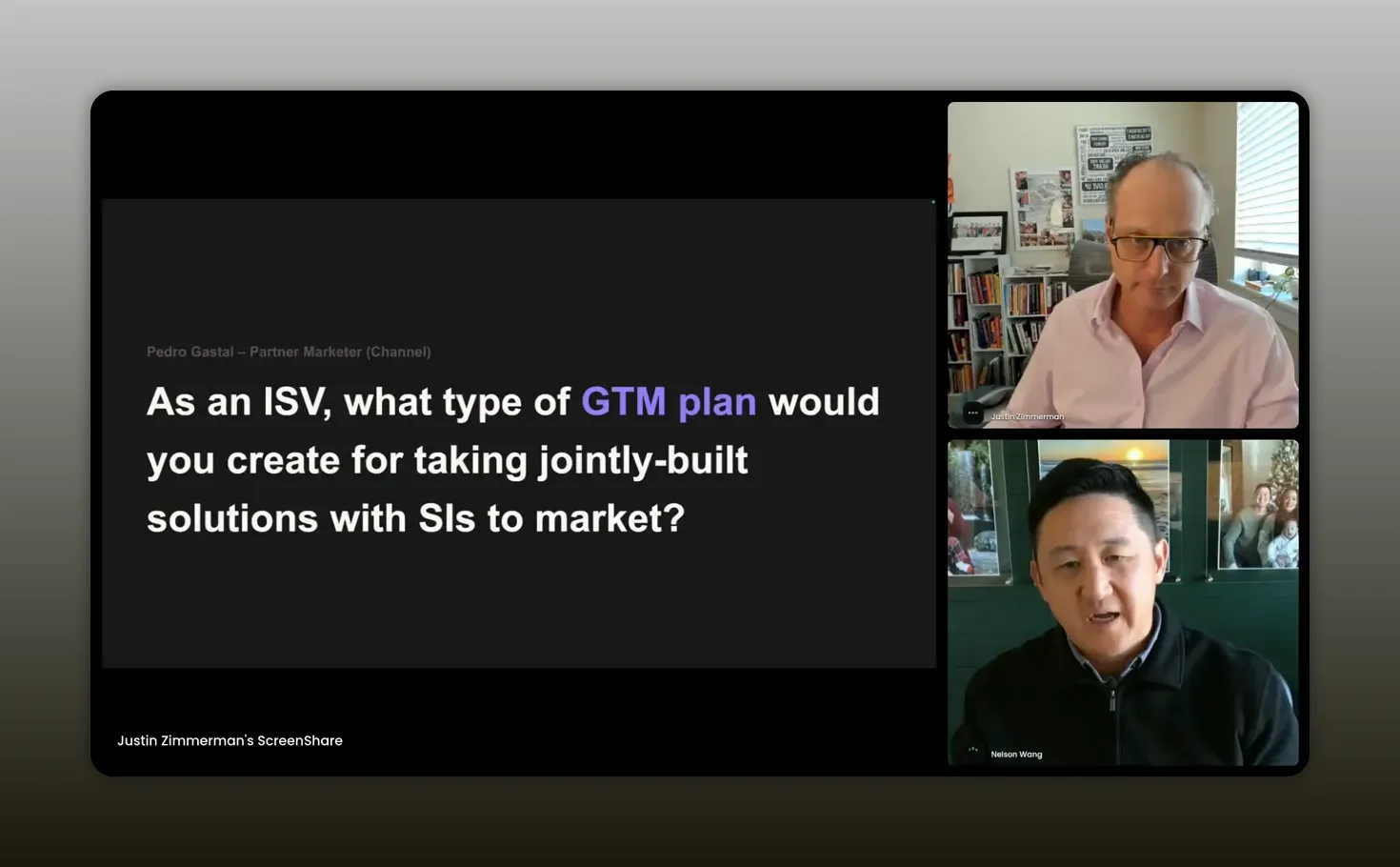
When you’re really deep in understanding the problem set and you can play it back step by step, you become the advisor. -Nelson Wang
Work backward from the buyer. Nelson lays out a step-by-step approach to create a repeatable ISV-SI GTM:
- Define ICP and economic buyer: Document industry, functional owner, use cases, and the measurable business outcomes they care about.
- Create outcome-driven messaging: Build a sales deck that speaks the buyer’s language—taxonomies, processes, KPIs. Use revenue impact examples (e.g., “this project can drive $10M revenue uplift”) rather than technical claims.
- Build customer-specific artifacts: For each ICP, produce a tailored deck, a demo script, a proposal template, and a POC plan that maps service pillars to outcomes.
- Enable partner delivery: Provide SOW templates, delivery playbooks, and training so partners can deliver the solution with consistent quality and customer satisfaction.
- Operationalize the POC: Run standardized proof-of-concept templates so partners and customers know exactly what success looks like and how long it should take.
- Gather case studies and close the loop: Capture qualitative and quantitative evidence of impact and feed it into future sales cycles.
Practical elements to include in your partner kit:
- Persona-specific demo environments and scripts
- POC templates with success criteria and timelines
- SOW and pricing templates for partners
- Case study templates and executive one-pagers
- Partner enablement decks with objection-handling scripts
Justin calls this deep operationalization—getting into the weeds to make partners look and act like your in-house team in front of customers. That shift converts partnerships from a “vendor” relationship into an advisor-led transformation.
Building an ecosystem from zero to scale
Nelson has built partner programs from scratch multiple times. His key lesson: focus beats volume. Early-stage teams should intentionally choose a small set of partner types to prove joint value before trying to scale to every possible partner.
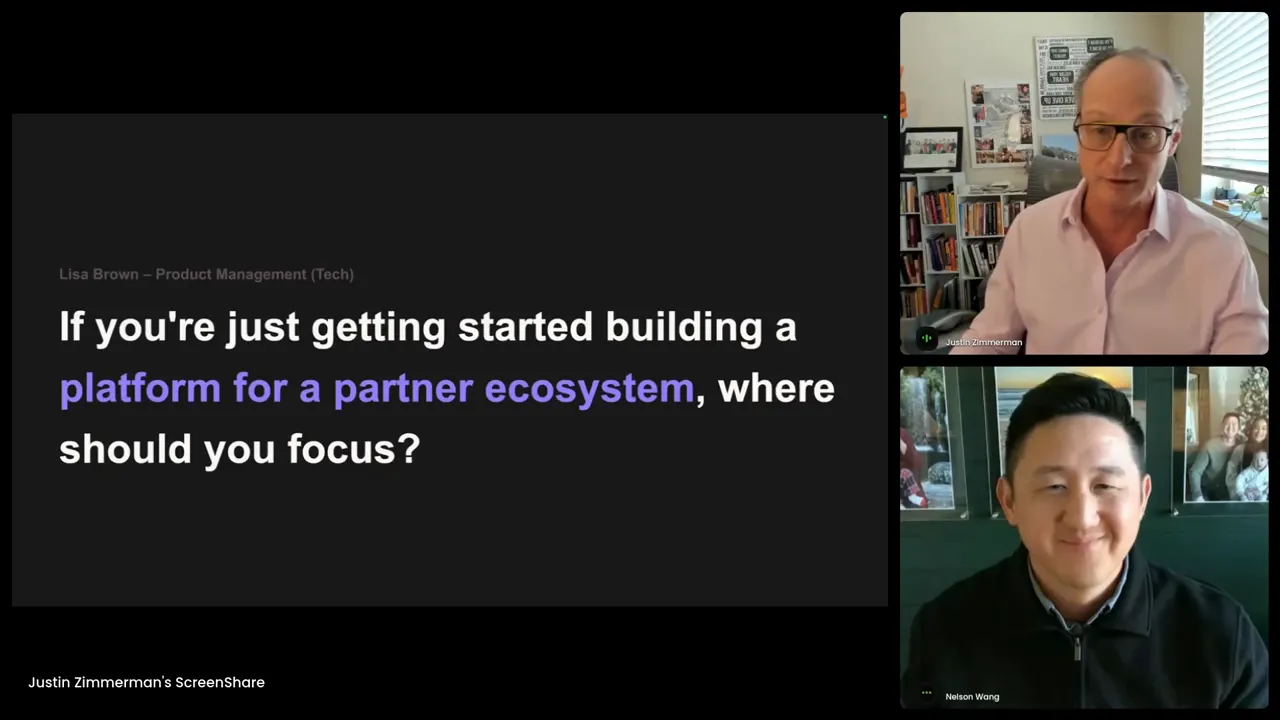
If I had to make a bet on a select number or even just one partner type that would make the biggest impact… where do I go make that bet? -Nelson Wang
Follow this five-step path from zero to ecosystem:
- Decide your focus play: Pick 1–3 partner types that map directly to your customer journey (e.g., implementation partners, niche ISVs, channel resellers).
- Find partner-market fit: Generate joint wins that prove the partnership type is repeatable—activated integrations, closed deals, uplift in usage, or improved retention.
- Document repeatable processes: Capture what worked in templates and blueprints so new partner engagements don’t require reinventing the wheel.
- Invest in scale infrastructure: Only after repeatability is proven should you invest in partner portals, developer docs, onboarding automation, and operations tooling.
- Measure and iterate: Use cohorts to validate that the partner type delivers measurable business outcomes across customers (e.g., cohort net retention, AR growth, CSAT benchmarks).
Nelson confesses a classic early mistake: recruiting too many partners too quickly. This leads to administrative drag and distracts from the partner-market fit experiments needed to identify the right route to scale.
Justin points out tools like developer portals and partner-facing platforms (for example, Partnerfleet) that can accelerate ISV integration adoption once you’ve proven the play. But he cautions: first find the play, then invest in the tooling to scale it.
Activating your sales team around partners
Getting sales engaged in partner motions is often about storytelling plus clear metrics. Nelson recommends tracking a few quantifiable KPIs and amplifying qualitative human stories from the field.
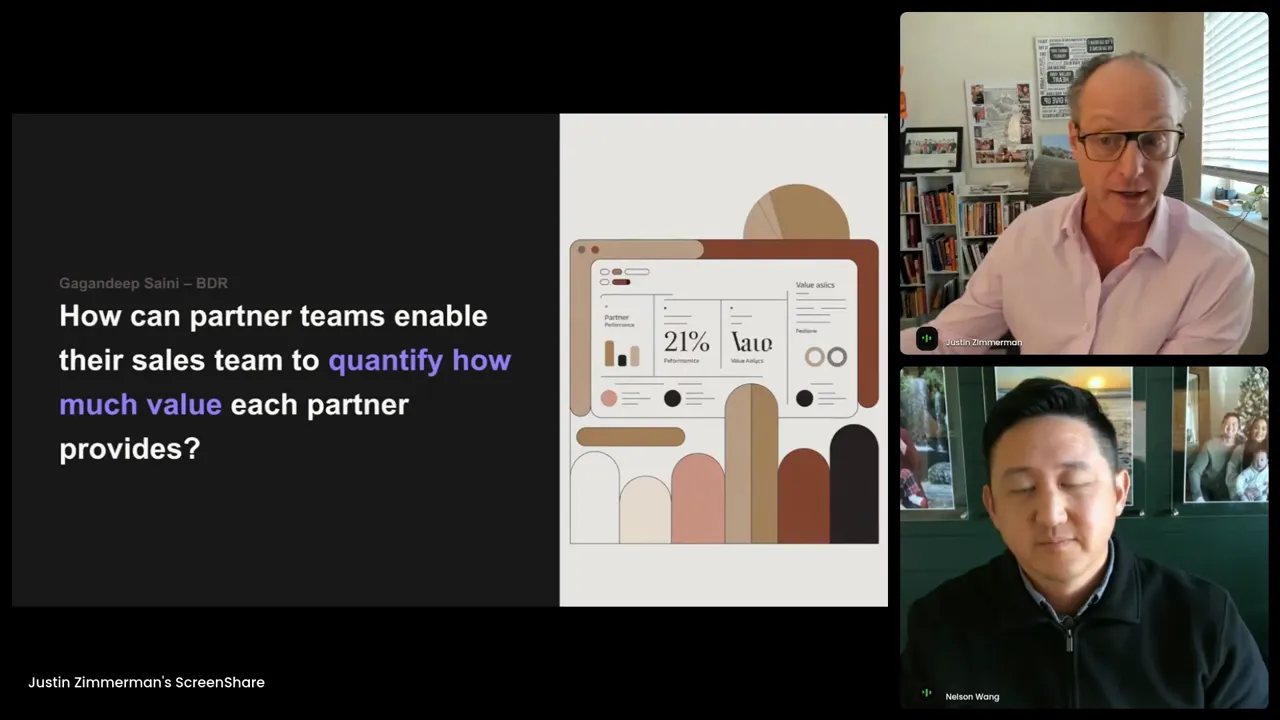
Once you have pockets of your best salespeople and CSMs talking about partner success stories, that starts to catch on like wildfire. -Nelson Wang
Metrics that move the needle with sales leaders:
- Deal size uplift: Show that partner-attached deals are larger on average (e.g., partner deals close at 1.8x ACV).
- Speed to close: Measure time-to-close improvements when partners are involved (e.g., deals accelerated by six months).
- Partner-sourced pipeline: Track pipeline and closed-won amounts sourced directly by partners.
- Retention and expansion: Highlight net retention improvement and cross-sell/upsell success for partner-delivered engagements.
- CSAT and qualitative feedback: Collect quotes and short stories from sales and customers that humanize the benefits.
Nelson emphasizes that numbers alone aren’t enough. When a sales rep tells a story about how a partner helped close a complex deal, their peers listen differently than if the partner team frames it. Justin adds that capturing short testimonials and elevating them internally creates social proof and motivates sales adoption.
Integration horror stories and lessons learned
No relationship is perfect. Nelson shared two categories of integration failures that reveal structural pitfalls—and how to avoid them.
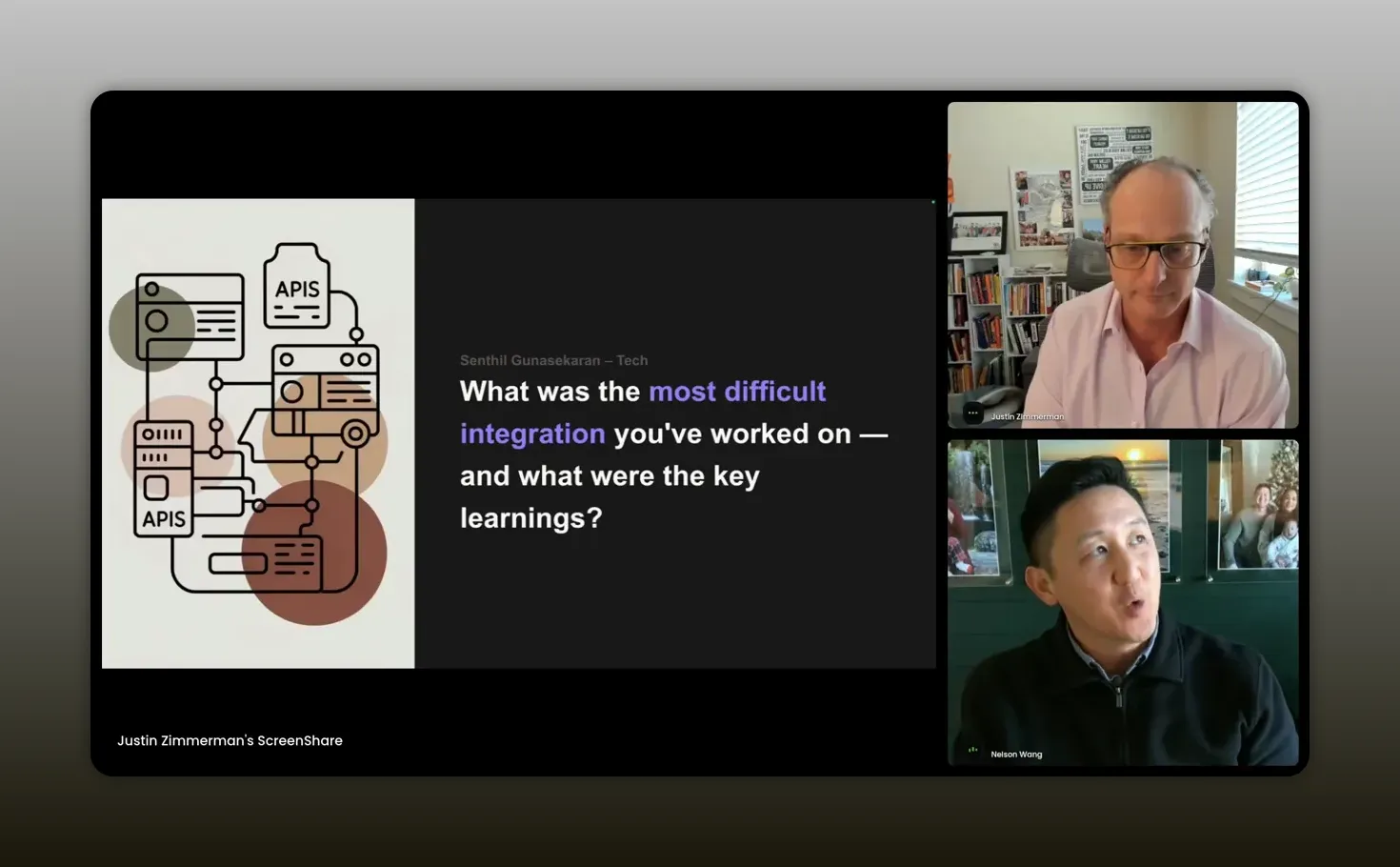
If you build for people, but not with people, the chances of adoption go down. -Justin Zimmerman
Failure mode one: low priority partners within a heavyweight account
- Situation: A major partner ecosystem relationship stalled because the integration landed low on the partner’s priority list.
- Symptom: Emails and business cases went unanswered. Progress stalled despite compelling economics.
- Fix: Build human relationships at multiple levels. Invest in in-person meetings with the right stakeholders. Sometimes the formal channels are slow; human-to-human conversations accelerate alignment.
Failure mode two: building every requested integration
- Situation: Teams reacted to product intake forms and built dozens of integrations that required maintenance and engineering effort but moved very little customer value.
- Symptom: Engineering resources consumed; limited impact on metrics (only a handful of integrations actually drove material adoption or revenue).
- Fix: Create a prioritization rubric that evaluates revenue impact, customer breadth and depth, feasibility, and time-to-value. Map requests to the rubric and force hard prioritization decisions. Accept that you won’t build everything.
Both cases point back to the same principle Nelson and Justin repeat: build with customers and partners, not for them. Co-design integrations, validate demand, and always estimate the expected business impact before committing engineering resources.
Operational templates and what to build first
Nelson has turned these practices into repeatable templates—sales decks, POC plans, SOWs, enablement kits, and partner scorecards. If you’re starting a program, prioritize building the following artifacts in this order:
- ICP and Buyer Personas — Document the buyer’s language, KPIs, and typical purchase process.
- Outcome-First Sales Deck — Create a short executive deck that ties the solution to measurable business outcomes and the SI’s service pillars.
- POC Template — Define success criteria, timeline, resources, and validation metrics.
- SOW Template — Standardize delivery approaches so partners can quote, deliver, and measure consistently.
- Partner Onboarding Checklist — A step-by-step sequence to take a partner from agreement to productivity in X days.
- Partner Scorecard — KPIs to track performance: pipeline, revenue, usage, CSAT, time-to-value.
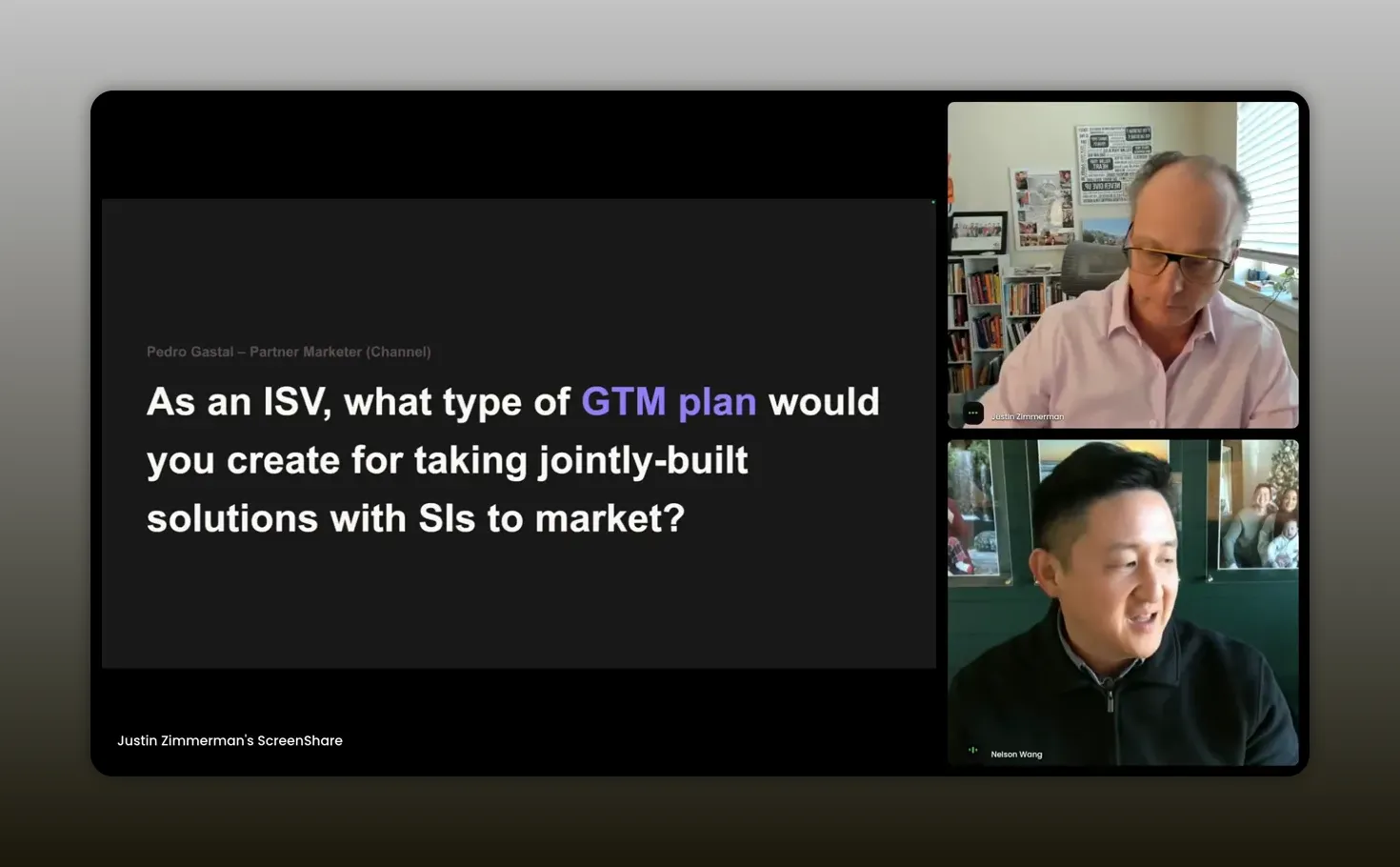
You have to be very deep in the weeds like a CEO would to create an amazing experience for partners. -Nelson Wang
Justin adds a practical tip: you don’t need to perfect every template before you start testing partnerships. Build minimum viable artifacts that let partners sell and deliver, then iterate as you collect evidence from live deals.
How to run repeatable partner POCs
A common tactical gap is the lack of a standard POC. Nelson proposes a simple, repeatable POC structure that partners can execute:
- Context & Objective: One pager that names the buyer, use case, and business outcome target.
- Success Criteria: 2–4 measurable KPIs (e.g., conversion rate lift, hours saved, cost reduced). Define thresholds for success/failure.
- Scope & Timeline: Minimal data and setup required, maximum 3–4 weeks for a quick win.
- Roles & Responsibilities: Who provides data, who configures the environment, who validates outcomes.
- Close Criteria: If success thresholds are hit, define the next commercial steps (SOW, subscription uplift, or expansion pilot).
This POC structure addresses the common mistakes of overly long pilots and unclear success criteria. It makes it easy for sales leaders and customers to sign off because they see a short path to measurable impact.
Content and enablement: what partners actually need
Partner enablement should include three tiers of content:
- Executive-level one-pagers for buyer conversations (outcome-focused, ROI-oriented).
- Prescriptive sales plays with demo scripts, objection handlers, and persona messaging.
- Delivery playbooks with SOW templates, implementation checklists, and post-go-live adoption plans.
Nelson recommends investing in demo environments keyed to the ICP. Generic demos don’t help. If you can provide partners with ready-to-run demos that match customer workflows, you reduce friction and improve win rates.
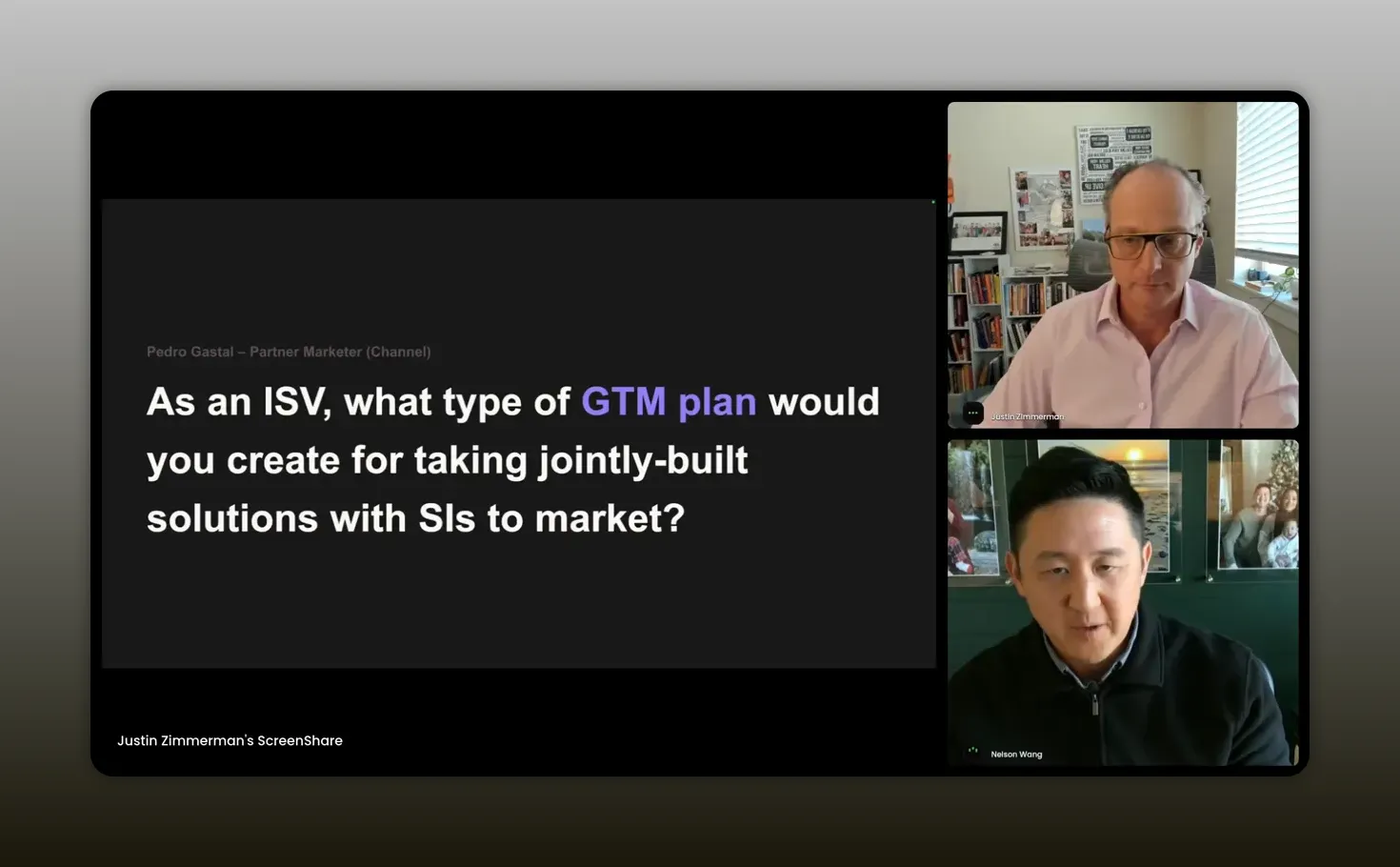
This is why you have to get really into the weeds — when you’re deep in the problem set you become the advisor. -Nelson Wang
Scaling ISV integrations
For ISVs, a developer portal and standardized integration SDKs become essential once you move past the first handful of integrations. But do not rush to build a portal until you have confirmed the integration priorities and partner demand.
Steps to scale integrations:
- Prove 3–5 integrations that deliver measurable outcomes (usage, retention, revenue uplift).
- Standardize APIs and create a published developer portal with code samples, data models, and test environments.
- Provide clear commercial models for embedded and co-sell revenue streams.
- Automate onboarding and certification to reduce admin work for partner engineers.
Justin compliments this with a reminder: tools accelerate scale only after you prove the play. Developer portals, ISV partner tools, and automation are levers—you must pull them at the right time.
Measuring success: partner KPIs that matter
Nelson recommends focusing on a small set of KPIs to measure partner program health:
- Partner-sourced pipeline and closed-won revenue
- Deal size with partner involvement vs. direct deals
- Time-to-close improvements
- Net retention uplift for customers delivered via partners
- Partner CSAT and customer CSAT on partner-delivered projects
- Number of integrations activated and active usage metrics
Qualitative signals—sales rep endorsements, customer testimonials, and partner feedback—are equally important. Justin notes that stories from the field often create the internal momentum needed to secure more resources for the partner program.
Operational roles and staffing
What people do you need on the partnership team? Nelson suggests starting lean with very clear responsibilities:
- Head of Partnerships — Sets strategy, prioritization, and executive alignment.
- Partner GTM Lead — Crafts co-sell materials, runs joint plays, and coordinates field motions.
- Partner Success / Enablement — Onboards partners, maintains templates, runs certifications.
- Technical Partner Engineer — Supports integrations and POCs, builds demo environments.
- Operations / Program Manager — Tracks metrics, manages portal, and runs partner scorecards.
Initially, a single generalist who understands customers, sales, and technical constraints can cover several of these functions. As you prove the play, hire specialists to scale each dimension.
Common partner contract and commercial patterns
Nelson highlights a few common commercial approaches based on partner type:
- Resellers/Channel: Margin or discount model, with revenue recognition shared on booked ARR.
- GSIs/Solution Providers: Services-first with co-selling credits, referral fees, and formal SOWs.
- ISVs: Revenue share on integrations, marketplace referral fees, or joint selling credits.
- Referral partners: Fixed-fee referral with simple contract language for quick onboarding.
Whatever model you choose, be transparent with partners about incentives and ensure they align with the effort required to deliver the customer outcome.
Partner playbook checklist — minimum viable items to ship
To start generating partner wins quickly, ship this “partner minimum viable kit”:
- ICP and one-page buyer profile
- Outcome-first sales deck
- Demo environment and demo script for the ICP
- Standardized POC template
- SOW and pricing template for partners
- Onboarding checklist and partner scorecard
Justin suggests packaging these assets into a single “partner kit” you hand to every partner during onboarding. This reduces friction, speeds up early wins, and gives you a baseline for measuring partner effectiveness.
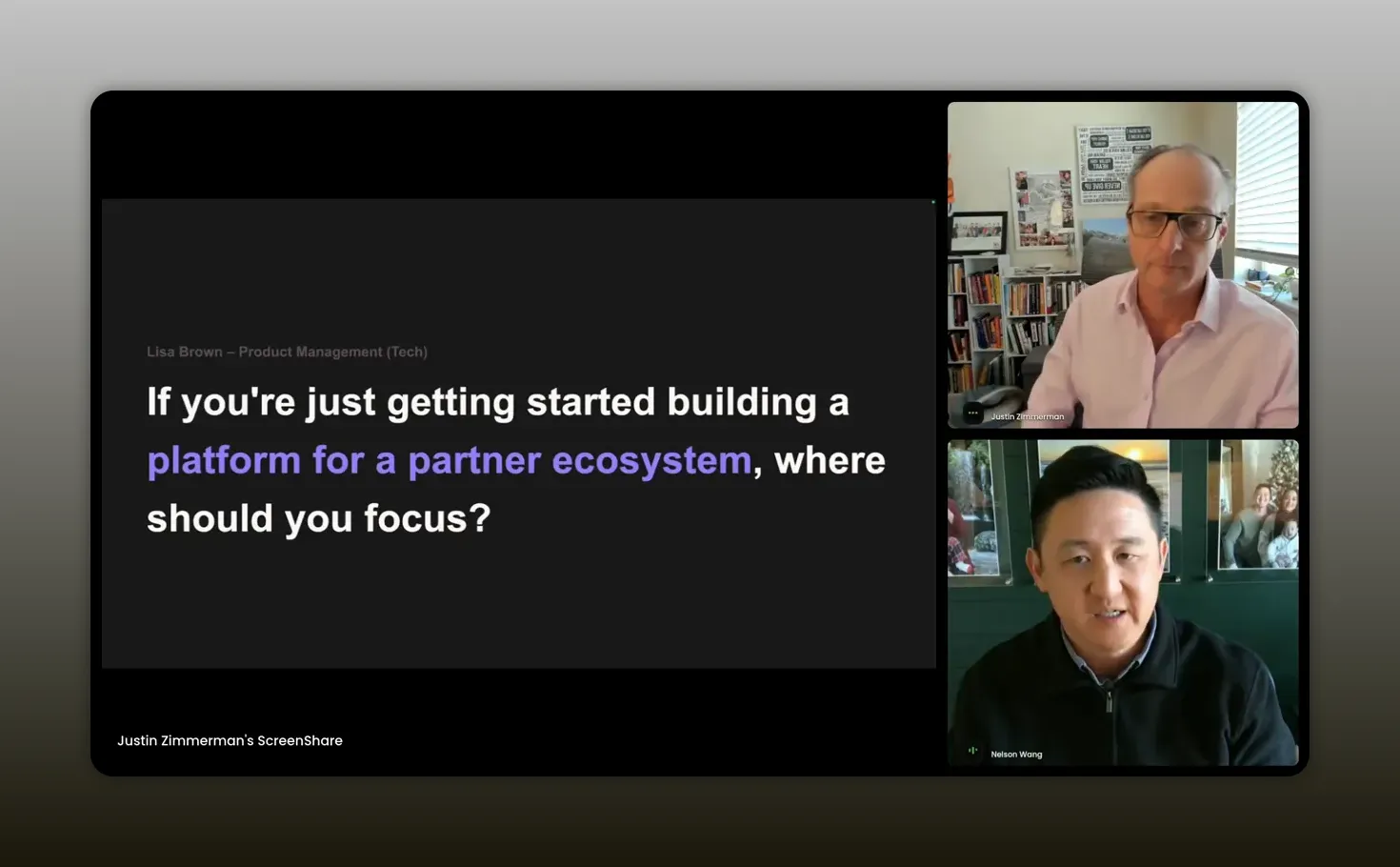
When you say yes to fewer partners and go deep with them, you get more repeatable, scalable outcomes. -Nelson Wang
FAQs
How do I decide whether to pursue a GSI relationship or focus on smaller partners?
Map the expected customer business value against the GSI’s typical engagement economics. If the customer outcome supports large services spend (high ACV, transformation scope), GSIs make sense. If the outcome is smaller in dollar terms, focus on ISVs, channel partners, or self-serve integrations that match your product economics.
What are the top metrics to convince my sales team to work with partners?
Deal size uplift, speed to close, partner-sourced pipeline, net retention for partner-delivered customers, and qualitative testimonials from sales reps. Use a mix of quantitative wins and human stories to make internal adoption contagious.
How many integrations should we build in year one?
Start small—only build integrations that map to measurable business outcomes for your target ICP. Prove 3–5 integrations that deliver measurable value before investing in a broader integration program or developer portal.
What does a minimal partner onboarding process look like?
A fast, repeatable onboarding includes an orientation call, access to the partner kit (sales deck, demo script, POC template, SOW template), technical access to demo environments, and a 30/60/90 day success plan with KPIs.
When should I invest in a partner portal or developer platform?
Invest once you have repeatable partner-market fit and a predictable set of integrations that justify automation. Tools accelerate scale, but if you invest too early you’ll waste money on processes that will change as the play evolves.
Conclusion
Partnerships are not magic—they are an operating discipline. Nelson’s counsel to start with the customer journey, pick a focused partner type, and validate partner-market fit is the right playbook for turning partnerships into measurable outcomes. Justin’s emphasis on operational artifacts—POC templates, demo environments, and outcome-focused decks—shows how to convert strategy to execution.
Do the work early: map your ICP, assess partner fit against the customer journey, and build the minimum viable partner kit that lets partners sell and deliver. Collect quantitative KPIs and qualitative stories from the field, then use them to earn buy-in from sales and product teams. When you combine customer centricity, repeatable processes, and the right partner incentives, partnerships become a scalable growth lever—not just a line item on the roadmap.